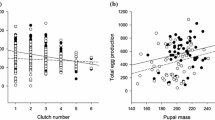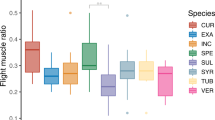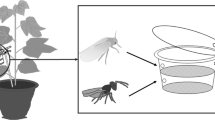Abstract
Males of several animals increase their reproductive success by territorial behaviour. In butterflies, males may defend a territory (i.e., territorial perching tactic), but this is assumed to be an energetically costly way to locate mates. Limitations of the energy budget may affect fight performance, and may, consequently, force males to adopt an alternative non-territorial searching behaviour (i.e., patrolling tactic) to maximize reproductive success. In this study, we tested to what extent behavioural tactics adopted by adult males of the butterfly Pararge aegeria (L.) were affected by the nutritional conditions during the larval stage. We compared the occurrence of territorial versus patrolling behaviour, lipid mass, flight muscle ratio, metabolic rate and spermatophore production of low quality males that were reared as a larva on drought-stressed host plants and control, high quality males. Low quality males were less likely to adopt the territorial perching tactic and emerged as adults with lower lipid mass than high quality males, but they were able to restore their lipid mass through adult feeding (and perhaps the breakdown of flight muscles). Host plant quality also affected spermatophore size. Independent of the larval food treatment, territorial perching males metabolised more lipids than non-territorial males, produced larger spermatophores and copulated for longer than males adopting non-territorial behaviour. We discuss the results relative to the co-existence of the behavioural tactics (perching and patrolling).

Similar content being viewed by others
References
Anderson DR (2008) Model based inference in the life sciences: a primer of evidence. Springer, Berlin
Andersson M (1994) Sexual selection. Princeton University Press, Princeton
Awmack CS, Leather SR (2002) Host plant quality and fecundity in herbivorous insects. Annu Rev Entomol 47:817–844
Baker HG, Baker I (1973) Amino acids in nectar and their evolutionary significance. Nature 241:543–545
Berwaerts K, Van Dyck H, Aerts P (2002) Does flight morphology relate to flight performance? An experimental test with the butterfly Pararge aegeria. Funct Ecol 16:484–491
Boggs CL (1997) Reproductive allocation from reserves and income in butterfly species with differing adult diets. Ecology 78:181–191
Boggs CL (2003) Environmental variation, life histories, and allocation. In: Boggs CL, Watt WB, Ehrlich PR (eds) Butterflies: ecology and evolution taking flight. Univ. Chicago Press, Chicago, pp 185–206
Boggs CL, Ross CL (1993) The effect of adult food limitation on life-history traits in Speyeria mormonia (Lepidoptera, Nymphalidae). Ecology 74:433–441
Burnham KP, Anderson DR (2002) Model selection and multimode inference, a practical information-theoretic approach. Springer, New York
Canavoso LE, Jouni ZE, Karnas KJ, Pennington JE, Wells MA (2001) Fat metabolism in insects. Annu Rev Nutr 21:23–46
Cook PA, Wedell N (1996) Ejaculate dynamics in butterflies: a strategy for maximizing fertilization success? Proc R Soc Lond (B) 263:1047–1051
Delisle J, Bouchard A (1995) Male larval nutrition in Choristoneura rosaceana (Lepidoptera: Tortricidae): an important factor in reproductive success. Oecologia 104:508–517
Delisle J, Hardy M (1997) Male larval nutrition influences the reproductive success of both sexes of the spruce budworm, Choristoneura fumiferana (Lepidoptera: Tortricidae). Funct Ecol 11:451–463
Dudley R (2000) The biomechanics of insect flight: form, function, evolution. Princeton University Press, Princeton
Fischer K, Fiedler K (2001) Effects of larval starvation on adult life-history traits in the butterfly species Lycaena tityrus (Lepidoptera : Lycaenidae). Entomol Gener 25:249–254
Garamszegi LZ (2011) Information-theoretic approaches to statistical analysis in behavioural ecology: an introduction. Behav Ecol Sociobiol 65:1–11
Gibbs M, Lace LA, Jones MJ, Moore AJ (2004) Intraspecific competition in the speckled wood butterfly Pararge aegeria: effect of rearing density and gender on larval life history. J Insect Sci 4:1–6
Gibbs M, Van Dyck H, Breuker CJ (2012) Development on drought stressed host plants affects life history, flight morphology and reproductive output relative to landscape structure. Evol Appl 5:66–75
Gross MR (1996) Alternative reproductive strategies and tactics: diversity within sexes. Trends Ecol Evol 11:92–98
Gross MR, Repka J (1998a) Game theory and inheritance in the conditional strategy. In: Dugatkin LA, Reeve HK (eds) Game theory and animal behaviour. Oxford University Press, Oxford, pp 168–187
Gross MR, Repka J (1998b) Stability with inheritance in the conditional strategy. J Theor Biol 192:445–453
Gurdon GB (1991) Nuclear transplantation in Xenopus. In: Kray B, Peng B (eds) Methods in cell biology, vol 36. Academic Press, London, pp 299–306
Gwynne DT (1990) Testing parental investment and the control of sexual selection in katydids: the operational sex ratio. Am Nat 119:601–610
Gwynne DT, Simmons LW (1990) Experimental reversal of courtship roles in an insect. Nature 346:172–174
Hack MA (1997) The effects of mass and age on standard metabolic rate in house crickets. Physiol Entomol 22:325–331
Karlsson B (1994) Feeding habits and change of body composition with age in three nymphalid butterfly species. Oikos 69:224–230
Kemp DJ, Alcock J (2003) Lifetime resource utilization, flight physiology, and the evolution of contest competition in territorial insects. Am Nat 162:290–301
Kemp DJ, Wiklund C (2001) Fighting without weaponry: a review of male-male contest competition in butterflies. Behav Ecol Sociobiol 49:429–442
Kemp DJ, Wiklund C, Van Dyck H (2006a) Contest behaviour in the speckled wood butterfly (Pararge aegeria): seasonal phenotypic plasticity and the functional significance of flight performance. Behav Ecol Sociobiol 59:403–411
Kemp DJ, Vukusic P, Rutowski RL (2006b) Stress-mediated covariance between nano-structural architecture and ultraviolet butterfly coloration. Funct Ecol 20:282–289
Lauwers K, Van Dyck H (2006) The cost of mating with a non-virgin male in a monandrous butterfly: experimental evidence from the speckled wood, Pararge aegeria. Behav Ecol Sociobiol 60:69–76
Leimar O, Norberg U, Wiklund C (2003) Habitat preference and habitat exploration in two species of satyrine butterflies. Ecography 26:474–480
Marden JH (1989) Bodybuilding dragonflies: costs and benefits of maximizing flight-muscle. Physiol Zool 62:505–521
Marshall LD, McNeil JN (1989) Spermatophore mass as an estimate of male nutrient investment: a closer look in Pseudaletia unipuncta (Haworth) (Lepidoptera, Noctuidae). Funct Ecol 3:605–612
May PG (1992) Flower selection and the dynamics of lipid reserves in two nectarivorous butterflies. Ecology 73:2181–2191
Maynard-Smith J (1979) Game theory and the evolution of behaviour. Proc R Soc Lond (B) 205:475–488
Merckx T, Van Dyck H, Karlsson B, Leimar O (2003) The evolution of movements and behaviour at boundaries in different landscapes: a common arena experiment with butterflies. Proc R Soc Lond (B) 270:1815–1821
Moreau J, Thiery D, Troussard JP, Benrey B (2007) Grape variety affects female but also male reproductive success in wild European grapevine moths. Ecol Entomol 32:747–753
O’Brien DM, Boggs CL, Fogel ML (2005) The amino acids used in reproduction by butterflies: a comparative study of dietary sources using compound specific stable isotope analysis. Physiol Biochem Zool 78:819–827
Oberhauser KS (1992) Rate of ejaculate and intermating intervals in monarch butterflies. Behav Ecol Sociobiol 31:367–373
Otronen M (1995) Energy reserves and mating success in males of the Yellow Dung Fly, Scathophaga stercoraria. Funct Ecol 9:683–688
Pellegroms B, Van Dongen S, Van Dyck H, Lens L (2009) Larval food stress differentially affects flight morphology in male and female speckled woods (Pararge aegeria). Ecol Entomol 34:387–393
Plaistow SJ, Siva-Jothy MT (1996) Energetic constraints and male mate-securing tactics in the damselfly Calopteryx splendens xanthostoma (Charpentier). Proc R Soc Lond (B) 263:1233–1239
Plaistow SJ, Tsubaki Y (2000) A selective trade-off for territoriality and non-territoriality in the polymorphic damselfly Mnais costalis. Proc R Soc Lond (B) 267:969–975
Proctor HC (1992) Effect of food deprivation on mate searching and spermatophore production in male water mites (Acari, Unionicolidae). Funct Ecol 6:661–665
Rutowski RL, Newton M, Schaeffer J (1983) Interspecific variation in the size of the nutrient investment made by male butterflies during copulation. Evolution 37:708–713
Scott JA (1974) Mate-locating behavior of butterflies. Am Nat 91:103–117
Shreeve TG (1986) The effect of weather on the life cycle of the speckled wood butterfly Pararge aegeria. Ecol Entomol 11:325–332
Stjernholm F, Karlsson B, Boggs CL (2005) Age-related changes in thoracic mass: possible reallocation of resources to reproduction in butterflies. Biol J Linn Soc 86:363–380
Svärd L, Wiklund C (1989) Mass and production rate of ejaculates in relation to monandry polyandry in butterflies. Behav Ecol Sociobiol 24:395–402
Talloen W, Van Dyck H, Lens L (2004) The cost of melanization: butterfly wing coloration under environmental stress. Evolution 58:360–366
Torres-Vila LM, Stockel J, Rodriguez-Molina MC (1997) Physiological factors regulating polyandry in Lobesia botrana (Lepidoptera: Tortricidae). Physiol Entomol 22:387–393
Van Dyck H (2003) A matter of design? Adaptative morphological variation in the speckled wood butterfly. In: Boggs CL, Watt WB, Ehrlich PR (eds) Butterflies: ecology and evolution taking flight. University of Chicago Press, Chicago, pp 353–366
Van Dyck H, Wiklund C (2002) Seasonal butterfly design: morphological plasticity among three developmental pathways relative to sex, flight and thermoregulation. J Evol Biol 15:216–225
Vande Velde L, Van Dyck H (2012) Lipid economy, flight activity and reproductive behaviour in the speckled wood butterfly: on the energetic cost of territory holding. Oikos (in press)
Vande Velde L, Damiens D, Van Dyck H (2011) Spermatophore and sperm allocation in males of the monandrous butterfly Pararge aegeria: the female’s perspective. Ethology 117:645–654
Warburg MS, Yuval B (1997) Effects of energetic reserves on behavioral patterns of Mediterranean fruit flies (Diptera: Tephritidae). Oecologia 112:314–319
Wickman PO (1992) Sexual selection and butterfly design: a comparative study. Evolution 46:1525–1536
Wiklund C, Persson A, Wickman PO (1983) Larval aestivation and direct development as alternative development as alternative strategies in the speckled wood butterfly Pararge aegeria in Sweden. Ecol Entomol 8:233–238
Yuval B, Kaspi R, Shloush S, Warburg MS (1998) Nutritional reserves regulate male participation in Mediterranean fruit fly leks. Ecol Entomol 23:211–215
Acknowledgments
Thanks are due to Christophe Pels and Gaëlle Rigaux for practical assistance, to Augustin Joiris for help with respirometry, to Gilles San Martin for statistical advice and to Katherine Mitchell for language editing. L. V. V. was supported by a FRIA PhD grant from the Fund for Scientific Research-FNRS (F.R.S.-FNRS). This research was also supported by a ARC-Research grant of the Académie Louvain/UCL (ARC Grant 10/15-031) to HVD and NS. This is publication no BRC 262 of the Biodiversity Research Centre (UCL).
Author information
Authors and Affiliations
Corresponding author
Rights and permissions
About this article
Cite this article
Vande Velde, L., Schtickzelle, N. & Van Dyck, H. Effect of larval food stress on male adult behaviour, morphology and reproductive investment in the butterfly Pararge aegeria . Evol Ecol 27, 221–234 (2013). https://doi.org/10.1007/s10682-012-9580-4
Received:
Accepted:
Published:
Issue Date:
DOI: https://doi.org/10.1007/s10682-012-9580-4




